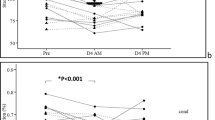Abstract
The article is devoted to the study of the state of the vascular wall based on the data on pulse wave velocity used as a vascular biomarker to predict and prevent early vascular aging. The studies were carried out on Russian cosmonauts who performed 6-month space flights using a Mobilograph device, which passed all the necessary tests, was certified for operation on board the International Space Station and allows evaluating the parameters of central hemodynamics. The experiment was carried out twice before the flight, every month during the flight, and also on days +4 and +8 after landing. Pulse wave velocity in all measurements was not shown to exceed the threshold values, thus suggesting the absence of vascular risk and the risk of cardiovascular pathologies in astronauts working in low-Earth orbit. However, this conclusion may be limited by the features of the method and the device used.



Similar content being viewed by others
REFERENCES
Arbeille, P., Provost, R., and Zuj, K., Carotid and femoral artery intima—media thickness during 6 months of spaceflight, Aerosp. Med. Hum. Perform., 2016, vol. 87, p. 449. https://doi.org/10.3357/AMHP.4493.2016
Garrett-Bakelman, F.E., Darshi, M., Green, S.J., et al., The NASA Twins Study: a multidimensional analysis of a year-long human spaceflight, Science, 2019, vol. 364, no. 6436. doi 8650https://doi.org/10.1126/science.aau
Lee, S.M., Ribeiro, L.C., Martin, D.S., et al., Arterial structure and function during and after long-duration spaceflight, J. Appl. Physiol., 2020, vol. 129, p. 108. https://doi.org/10.1152/japplphysiol.00550.2019
Arbeille, P., Provost, R., and Zuj, K., Carotid and femoral arterial wall distensibility during long-duration spaceflight, Aerosp. Med. Hum. Perform., 2017, vol. 88, p. 924. https://doi.org/10.3357/AMHP.4884
Hughson, R.L., Helm, A., and Durante, M., Heart in space: effect of the extraterrestrial environment on the cardiovascular system, Nat. Rev. Cardiol., 2018, vol. 15, p. 167. https://doi.org/10.1038/nrcardio.157
Laurent, S., van Bortel, L.M., Boutouyrie, P., et al., Expert consensus document on the measurement of aortic stiffness in daily practice using carotid-femoral pulse wave velocity, J. Hypertens., 2012, vol. 30, no. 3, p. 445.
Oliver, J.J. and Webb, D.J., Noninvasive assessment of arterial stiffness and risk of atherosclerotic events, Arterioscler. Thromb. Vasc. Biol., 2003, vol. 23, p. 554.
Pietri, P., Vyssoulis, G., Vlachopoulos, C., et al., Relationship between low-grade inflammation and arterial stiffness in patients with essential hypertension, J. Hypertens., 2006, vol. 24, no. 11, p. 2231.
Navasiolava, N., Yuan, M., Murphy, R., et al., Vascular and microvascular dysfunction induced by microgravity and its analogs in humans: mechanisms and countermeasures, Front. Physiol., 2020. https://doi.org/10.3389/fphys.2020.00952
Hughson, R.L., et al., Increased postflight carotid artery stiffness and inflight insulin resistance resulting from 6-mo spaceflight in male and female astronauts, Am. J. Physiol.: Heart Circ. Physiol., 2016, vol. 310, p. H628. https://doi.org/10.1152/ajpheart.00802.2015
Mancia, G., Fagard, R., Narkiewicz, K., et al., ESH/ESC guidelines for the management of arterial hypertension, Eur. Heart J., 2013, vol. 34, p. 2159.
Khoshdel, A.R., Thakkinstian, A., Carney, S.L., and Attia, J., Estimation of an age-specific reference interval for pulse wave velocity: a meta-analysis, J. Hypertens., 2006, vol. 24. suppl. 7, p. 1231.
Weber, T., Wassertheurer, S., Hametner, B., et al., Noninvasive methods to assess pulse wave velocity: comparison with the invasive gold standard and relationship with organ damage, J. Hypertens., 2015, vol. 33, no. 5, p. 1023. https://doi.org/10.1097/HJH.0000000000000518
Funding
The studies were carried out within the framework of the basic topic of the Russian Academy of Sciences no. 64.1 for 2013–2023. Analysis of pre- and postflight data was performed under international contracts nos. 16-23-07 (March 29, 2016–December 31, 2018) and 07-35 (September 7, 2018–December 31, 2020).
Author information
Authors and Affiliations
Corresponding author
Ethics declarations
COMPLIANCE WITH ETHICAL STANDARDS
All procedures performed in studies involving human participants were in accordance with the biomedical ethics principles formulated in the 1964 Helsinki Declaration and its later amendments and approved by the local Bioethics Committee of the Institute of Biomedical Problems, Russian Academy of Sciences (Moscow).
CONFLICT OF INTERESTS
The authors declare that they do not have a conflict of interest.
INFORMED CONSENT
Each study participant provided a voluntary written informed consent signed by him after explaining to him the potential risks and benefits, as well as the nature of the upcoming study.
Additional information
Translated by E. Babchenko
Rights and permissions
About this article
Cite this article
Luchitskaya, E.S., Funtova, I.I., Tank, J. et al. Measurement of Parameters Characterizing Early Vascular Aging with the Use of an Oscillometric Method during Spaceflight. Hum Physiol 48, 851–855 (2022). https://doi.org/10.1134/S036211972207012X
Received:
Published:
Issue Date:
DOI: https://doi.org/10.1134/S036211972207012X




